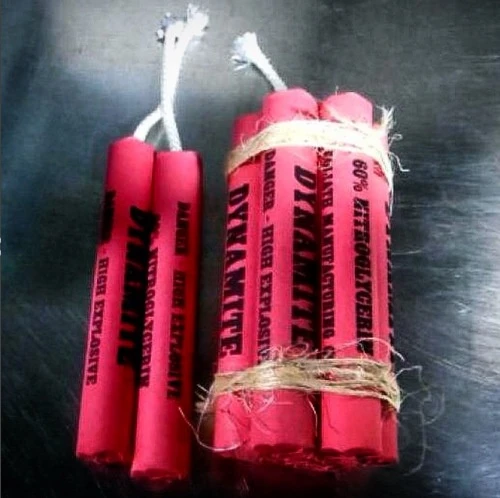M-80 explosives, often simply called “M-80s,” are a legendary class of powerful firecrackers that have a fascinating history. Originally designed for military purposes, these small but mighty explosives have become well-known in both the consumer and regulatory spheres. Whether you’re curious about their origin, legality, or myths, this comprehensive article breaks down everything you need to know about M-80s.

What Are M-80 Explosives?
M-80s are large firecrackers that pack a punch. Initially created in the mid-20th century for the U.S. military, they were used to simulate the sound of explosions or artillery fire during training exercises. The name “M-80” stems from military nomenclature, where “M” stands for “standard” equipment and “80” represents the 80 grains (5.2 grams) of flash powder used in each device.
As time passed, these explosives found their way into the consumer market, primarily as fireworks. The civilian versions of M-80s are typically made from a small cardboard tube, often red, and contain about 45 grains (3 grams) of flash powder. The design includes a fuse, usually a cannon or Visco fuse, that allows for ignition.
How M-80s Differ from Regular Firecrackers
What makes M-80s stand out compared to regular firecrackers is their higher explosive power. While standard firecrackers contain small amounts of black powder, M-80s are packed with flash powder, which is significantly more volatile and produces a louder bang. This is why M-80s are often classified as “salutes,” a term that refers to pyrotechnics designed to create a loud report rather than a colorful display.
The Legality of M-80s: A Complex History
When it comes to M-80s, legality varies significantly depending on the country and even within different states in the U.S. The regulation of these explosives is a matter of public safety, given their potential to cause harm if misused.
M-80s in Canada
In Canada, M-80s are completely illegal. The law prohibits their importation, possession, transportation, storage, and manufacture. Canadian authorities take a firm stance on explosive devices, categorizing M-80s as hazardous materials due to their potential to cause serious injuries or property damage.
M-80s in the United States
In the United States, M-80s have undergone various levels of regulation since the 1960s. Concerns over safety led to the introduction of the Federal Hazardous Substances Labeling Act in 1966, which was further reinforced by the Child Protection Act of the same year. These regulations set limits on the amount of explosive material that could be used in consumer fireworks.

The most significant restriction came in 1975, when the maximum permissible amount of flash powder in consumer-grade fireworks was reduced to 50 milligrams, significantly lower than the 5.2 grams found in authentic M-80s. As a result, the sale of traditional M-80s to the general public is illegal, and possession of them requires a federal explosives license.
Despite this, legal consumer fireworks are still available in the form of smaller firecrackers with up to 50 milligrams of flash powder. While less potent than genuine M-80s, these fireworks can still be quite dangerous if not handled properly.
Federal Licensing for M-80s
Individuals in the U.S. with a federal explosives license issued by the Bureau of Alcohol, Tobacco, Firearms and Explosives (ATF) can purchase M-80s for specific purposes, such as agricultural use. These explosives are sometimes distributed to farmers to help deter wildlife that may damage crops.
Imitation M-80s: How to Spot the Fakes
With the strict regulations on M-80s, the consumer market has seen an influx of imitation firecrackers designed to mimic the appearance and name of M-80s. These knock-offs often feature similar packaging, such as the classic red tube with end caps, but they contain significantly less flash powder—typically around 30 to 50 milligrams.
Fake M-80s often have a plaster or filler material surrounding the powder capsule, making the device appear larger than it actually is. In contrast, real M-80s are tightly packed with flash powder and sealed with paper end caps. The fuse placement is also different; authentic M-80s have a central fuse, whereas imitation versions may have fuses protruding from one end.
Myths vs. Reality: Are M-80s as Strong as Dynamite?
A common urban legend suggests that M-80s are equivalent to a quarter stick of dynamite. However, this is not accurate. While M-80s do contain a considerable amount of flash powder, dynamite is made from a stable nitroglycerin-based high explosive, making it far more powerful than the low explosive powder found in firecrackers. In short, M-80s may be loud and dangerous, but they’re nowhere near the level of dynamite.

The Dangers of M-80s: Why They’re Heavily Regulated
M-80s can cause significant harm if mishandled. Their high flash powder content creates a powerful explosion that can lead to severe injuries, including burns, hearing damage, and even loss of limbs. For this reason, their sale and distribution are closely monitored, and handling them requires proper training and precautions.
While genuine M-80s are largely restricted to professional use, smaller consumer-grade fireworks can still pose risks. Improper use, such as lighting multiple firecrackers at once or attempting to modify them, increases the likelihood of accidents.
Conclusion: The Legacy of M-80 Explosives
M-80s have a storied past, evolving from military tools to consumer fireworks and, ultimately, becoming highly regulated explosives. Despite their reduced presence in the consumer market, M-80s remain iconic among fireworks enthusiasts, symbolizing power and danger. Their regulation underscores the balance between allowing recreational use of fireworks and ensuring public safety. Whether admired from a historical perspective or approached with caution, M-80s are a reminder of the explosive allure that firecrackers have held for generations.